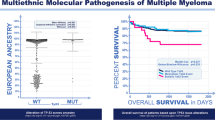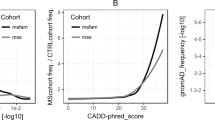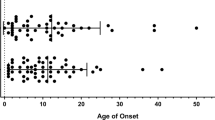Abstract
Perforin is involved in cell-mediated cytotoxicity and mutations of its gene (PRF1) cause familial hemophagocytic lymphohistiocytosis (FLH2). PRF1 sequencing in 190 patients with multiple sclerosis and 268 controls detected two FLH2-associated variations (A91V, N252S) in both groups and six novel mutations (C999T, G1065A, G1428A, A1620G, G719A, C1069T) in patients. All together, carriers of these variations were more frequent in patients than in controls (phenotype frequency: 17 vs 9%, P=0.0166; odds ratio (OR)=2.06, 95% confidence interval (CI): 1.13–3.77). Although A91V was the most frequent variation and displayed a trend of association with multiple sclerosis (MS) in the first population of patients and controls (frequency of the 91V allele: 0.076 vs 0.043, P=0.044), we used it as a marker to confirm PRF1 involvement in MS and assessed its frequency in a second population of 966 patients and 1520 controls. Frequency of the 91V allele was significantly higher in patients than in controls also in the second population (0.075 vs 0.058%, P=0.019). In the combined cohorts of 1156 patients and 1788 controls, presence of the 91V allele in single or double dose conferred an OR=1.38 (95% CI=1.10–1.74). These data suggest that A91V and possibly other perforin variations indicate susceptibility to MS.
This is a preview of subscription content, access via your institution
Access options
Subscribe to this journal
Receive 6 digital issues and online access to articles
$119.00 per year
only $19.83 per issue
Buy this article
- Purchase on Springer Link
- Instant access to full article PDF
Prices may be subject to local taxes which are calculated during checkout


Similar content being viewed by others
Accession codes
References
Compston A, Coles A . Multiple sclerosis. Lancet 2002; 359: 1221–1231.
Weinshenker BG . The natural history of multiple sclerosis. Neurol Clin 1995; 13: 119–146.
Sospedra M, Martin R . Immunology of multiple sclerosis. Annu Rev Immunol 2005; 23: 683–747.
Steinman L, Martin R, Bernard C, Conlon P, Oksenberg JR . Multiple sclerosis: deeper understanding of its pathogenesis reveals new targets for therapy. Annu Rev Neurosci 2002; 25: 491–505.
Howe CL, Rodriguez M . Remyelination as neuroprotection. In: Waxman SG (ed). Multiple Sclerosis as a Neuronal Disease. Elsevier Academic Press: San Diego, 2005, pp 389–419.
Babbe H, Roers A, Waisman A, Goebels N, Hohlfeld R, Friese M et al. Clonal expansions of CD8(+) T cells dominate the T cell infiltrate in active multiple sclerosis lesions as shown by micromanipulation and single cell polymerase chain reaction. J Exp Med 2000; 192: 393–404.
Bitsch A, Schuchardt J, Bunkowski S, Kulnann T, Brück W . Acute axonal injury in multiple sclerosis. Correlation with demyelination and inflammation. Brain 2000; 123: 1174–1183.
Trapani JA, Smyth MJ . Functional significance of the perforin/granzyme cell death pathway. Nat Rev Immunol 2002; 2: 735–747.
Stepp SE, Dufourcq-Lagelouse R, Le Deist F, Bhawan S, Certain S, Mathew PA et al. Perforin gene defects in familial hemophagocytic lymphohistiocytosis. Science 1999; 286: 957–959.
Clementi R, zur Stadt U, Savoldi G, Varoitto S, Conter V, De Fusco C et al. Six novel mutations in the PRF1 gene in children with haemophagocytic lymphohistiocytosis. J Med Genet 2001; 38: 643–646.
Clementi R, Chiocchetti A, Cappellano G, Cerutti E, Ferretti M, Orilieri E et al. Variations of the perforin gene in patients with autoimmunity/lymphoproliferation and defective Fas function. Blood 2006; 108: 3079–3084.
Orilieri E, Cappellano G, Clementi R, Cometa A, Ferretti M, Cerutti E et al. Variations of the perforin gene in patients with type 1 diabetes. Diabetes 2008; 57: 1078–1083.
Goertsches R, Villoslada P, Comabella M, Montalban X, Navarro A, de la Concha EG . A genomic screen of Spanish multiple sclerosis patients reveals multiple loci associated with the disease. J Neuroimmunol 2003; 143: 124–128.
Goertsches R, Comabella M, Navarro A, Perkal H, Montalban X . Genetic association between polymorphisms in the ADAMTS14 gene and multiple sclerosis. J Neuroimmunol 2005; 164: 140–147.
Goertsches R, Baranzini SE, Morcillo C, Nos C, Camiña M, Oksenberg JR et al. Evidence for association of chromosome 10 open reading frame (C10orf27) gene polymorphisms and multiple sclerosis. Mult Scler 2008; 14: 412–414.
Trambas C, Gallo F, Pende D, Marcenaro S, Moretta L, De Fusco C et al. A single amino acid change, A91V, leads to conformational changes that can impair processing to the active form of perforin. Blood 2005; 106: 932–937.
Voskoboinik I, Thia MC, Trapani JA . A functional analysis of the putative polymorphisms A91V and N252S and 22 missense perforin mutations associated with familial hemophagocytic lymphohistiocytosis. Blood 2005; 105: 4700–4706.
Risma KA, Frayer RW, Filipovich AH, Sumegi J . Aberrant maturation of mutant perforin underlies the clinical diversity of hemophagocytic lymphohistiocytosis. J Clin Invest 2006; 116: 182–192.
Voskoboinik I, Sutton VR, Ciccone A, House CM, Chia J, Darcy PK et al. Perforin activity and immune homeostasis: the common A91V polymorphism in perforin results in both pre- and post-synaptic defects in function. Blood 2007; 110: 1184–1190.
Mehta PA, Davies SM, Kumar A, Devidas M, Lee S, Zamzow T et al. Perforin polymorphism A91V and susceptibility to B-precursor childhood acute lymphoblastic leukaemia: a report from the Children's Oncology group. Leukemia 2006; 20: 1539–1541.
Clementi R, Locatelli F, Dupré L, Garaventa A, Emmi L, Bregni M et al. A proportion of patients with lymphoma may harbor mutations of the perforin gene. Blood 2005; 105: 4424–4428.
Voskoboinik I, Smyth MJ, Trapani JA . Perforin-mediated target-cell death and immune homeostasis. Nat Rev Immunol 2006; 6: 940–952.
Cartegni L, Chew SL, Krainer AR . Listening to silence and understanding nonsense: exonic mutations that affect splicing. Nat Rev Genet 2002; 3: 285–298.
Lavner Y . Kotlar codon bias as a factor in regulating expression via translation rate in the human genome. Gene 2005; 345: 127–138.
Kotlar D, Lavner Y . The action of selection on codon bias in the human genome is related to frequency, complexity, and chronology of amino acids. BMC Genomics 2006; 7: 67.
Shabalina SA, Ogurtsov AY, Spiridonov NA . A periodic pattern of mRNA secondary structure created by the genetic code. Nucleic Acids Res 2006; 34: 2428–2437.
Komar AA . Genetics. SNPs, silent but not invisible. Science 2007; 315: 466–467.
Martin MM, Buckenberger JA, Jiang J, Malana GE, Nuovo GJ, Chotani M et al. The human angiotensin II type 1 receptor +1166 A/C polymorphism attenuates microRNA-155 binding. J Biol Chem 2007; 282: 24262–24269.
Lee-Kirsch MA, Gong M, Chowdhury D, Senenko L, Engel K, Lee YA et al. Mutations in the gene encoding the 3′-5′ DNA exonuclease TREX1 are associated with systemic lupus erythematosus. Nat Genet 2007; 39: 1065–1067.
Lesage S, Zouali H, Cézard JP, Colombel JF, Belaiche J, Almer S et al. CARD15/NOD2 mutational analysis and genotype–phenotype correlation in 612 patients with inflammatory bowel disease. Am J Hum Genet 2002; 70: 845–857.
Lunemann JD, Munz C . Epstein–Barr virus and multiple sclerosis. Curr Neurol 2007; 7: 253–258.
Chuang HC, Lay JD, Hsieh WC, Su IJ . Pathogenesis and mechanism of disease progression from hemophagocytic lymphohistiocytosis to Epstein–Barr virus-associated T-cell lymphoma: nuclear factor-kappaB pathway as a potential therapeutic target. Cancer Sci 2007; 98: 1281–1287.
Su MW, Pyarajan S, Chang JH, Yu CL, Jin YJ, Stierhof YD et al. Fratricide of CD8+ cytotoxic T lymphocytes is dependent on cellular activation and perforin-mediated killing. Eur J Immunol 2004; 34: 2459–2470.
Badovinac VP, Hamilton SE, Harty JT . Viral infection results in massive CD8+ T cell expansion and mortality in vaccinated perforin-deficient mice. Immunity 2003; 18: 463–474.
Zhou S, Ou R, Huang L, Moskophidis D . Critical role for perforin-, Fas/FasL-, and TNFR1-mediated cytotoxic pathways in down-regulation of antigen-specific T cells during persistent viral infection. J Virol 2002; 76: 829–840.
de Saint Basile G, Fischer A . Defective cytotoxic granule-mediated cell death pathway impairs T lymphocyte homeostasis. Curr Opin Rheumatol 2003; 15: 436–445.
Comi C, Leone M, Bonissoni S, DeFranco S, Bottarel F, Mezzatesta C et al. Defective T cell Fas function in patients with multiple sclerosis. Neurology 2000; 55: 921–927.
Chiocchetti A, Comi C, Indelicato M, Castelli L, Mesturini R, Bensi T et al. Osteopontin gene haplotypes correlate with multiple sclerosis development and progression. J Neuroimmunol 2005; 63: 172–178.
Hur EM, Youssef S, Haws ME, Zhang SY, Sobel RA, Steinman L . Osteopontin-induced relapse and progression of autoimmune brain disease through enhanced survival of activated T cells. Nat Immunol 2007; 8: 74–83.
Comabella M, Pericot I, Goertsches R, Nos C, Castello M, Blas Navarro J et al. Plasma osteopontin levels in multiple sclerosis. J Neuroimmunol 2005; 158: 231–239.
Vogt MH, Lopatinskaya L, Smits M, Polman CH, Nagelkerken L . Elevated osteopontin levels in active relapsing-remitting multiple sclerosis. Ann Neurol 2003; 53: 819–822.
McDonald WI, Compston A, Edan G, Goodkin D, Hartung HP, Lublin FD et al. Recommended diagnostic criteria for multiple sclerosis: guidelines from the International Panel on the diagnosis of multiple sclerosis. Ann Neurol 2001; 50: 121–127.
Weinshenker BG, Bass B, Rice GP, Noseworthy J, Carriere W, Baskerville J et al. The natural history of multiple sclerosis: a geographically based study: I. Clinical course and disability. Brain 1989; 112: 133–146.
Trojano M, Avorio C, Mannari C, Calò A, De Robertis F, Serio G et al. Multivariate analysis of predictive factors of multiple sclerosis course with a validated method to assess clinical events. J Neurol Neurosurg Psychiatry 1995; 58: 300–306.
Lublin FD, Reingold SC . Defining the clinical course of multiple sclerosis: results of an international survey. Neurology 1996; 48: 907–911.
Roxburgh RH, Seaman SR, Masterman T, Hensiek AE, Sawcer SJ, Vukusic S et al. Multiple sclerosis severity score: using disability and disease duration to rate disease severity. Neurology 2005; 64: 1144–1151.
International Committee of Medical Journal Editors. Protection of patients' rights to privacy. BMJ 1995; 311: 1272.
D'Alfonso S, Bolognesi E, Guerini FR, Barizzone N, Bocca S, Ferrante D et al. A sequence variation in the MOG gene is involved in multiple sclerosis susceptibility in Italy. Genes Immun 2008; 9: 7–15.
Acknowledgements
This work was partially supported by FISM grant 2005/R/10 (Genoa), Telethon grant E1170 (Rome), AIRC (Milan), PRIN Project (MIUR, Rome), Compagnia di San Paolo (Turin), Fondazione Cassa di Risparmio di Cuneo (Cuneo), Regione Piemonte (Ricerca Sanitaria Finalizzata Project and Ricerca Sanitaria Applicata-CIPE Project), Associazione ‘Amici di Jean’ (Turin), Fondazione Lagrange (Turin) and Centro Dino Ferrari (Milan).
Author information
Authors and Affiliations
Corresponding author
Additional information
Disclosure
The authors report no conflict of interest.
Rights and permissions
About this article
Cite this article
Cappellano, G., Orilieri, E., Comi, C. et al. Variations of the perforin gene in patients with multiple sclerosis. Genes Immun 9, 438–444 (2008). https://doi.org/10.1038/gene.2008.35
Received:
Revised:
Accepted:
Published:
Issue Date:
DOI: https://doi.org/10.1038/gene.2008.35
Keywords
This article is cited by
-
Variations of the perforin gene in patients with chronic inflammatory demyelinating polyradiculoneuropathy
Genes & Immunity (2015)
-
Heterozygosity for the common perforin mutation, p.A91V, impairs the cytotoxicity of primary natural killer cells from healthy individuals
Immunology & Cell Biology (2015)
-
Cytophagic histiocytic panniculitis, hemophagocytic lymphohistiocytosis and undetermined autoimmune disorder: reconciling the puzzle
Italian Journal of Pediatrics (2014)
-
Recurrent subacute post-viral onset of ataxia associated with a PRF1 mutation
European Journal of Human Genetics (2013)
-
Perforin deficiency and susceptibility to cancer
Cell Death & Differentiation (2010)



